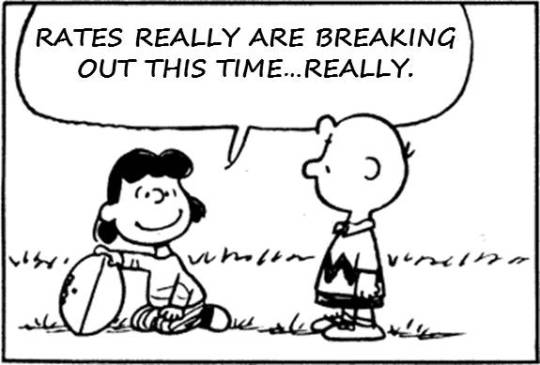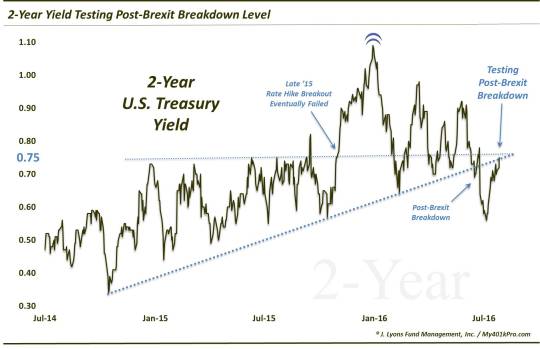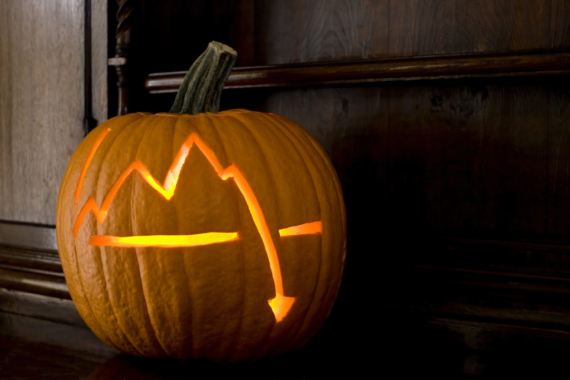A Real Opportunity For The Rising Rates Crowd?

2-Year Treasury Yields are testing the point of their post-Brexit breakdown; re-taking that level may actually give rates some upward momentum.
Quick quiz: where did the 2-Year Treasury Yield top out in 1981? Answer: 17% …17%!!!! Now, the world has roughly $10 trillion in debt securities – much of it 10-year government debt – where you actually have to pay to lend money. It is a strange world indeed – though, is it any stranger than getting paid 17% on 2-year paper? If any 2 data points tell you that financial markets go through cycles, it is those two. And just when investors collectively find a reversal in the cycle the most implausible, a shift becomes possible. So, while we are not predicting a radical upward shift in interest rates, it does seem like the worldwide collective acceptance of indefinitely low rates is beginning to set the groundwork from which a material rise in rates may be possible.
Though, again, we are not predicting a turn higher. Doing so would be going against the trend of the past – 35 years. Betting against bonds has been quite the widow-maker, particularly over the past decade when near-unanimous expectations for rising interest rates has been the norm. That’s a lot of widows. We have made light, over the past few years, of the countless head-fakes in rates and the countess market participants who took that bait – likening the phenomenon to Lucy yanking the football away from Charlie Brown every time he attempted to kick it.
So is it possible ol’ Chuck finally gets his foot into one? We’re not sure, but for once, a decent opportunity for rising rates to gather some momentum may be at hand. It’s typically been the bond bulls that have been presented with the opportunity to shine over the past 35 years, and they have responded to the challenge every time.
So what’s the setup for the bears? Late last year, as the Fed was preparing the market for an interest rate hike, the 2-year yield broke out above its 12-month range, finally surpassing the 0.75% level that had contained it on probably a dozen occasions. As we surmised back then, one probably shouldn’t get too excited about the “breakout” being sustained, given the price history and the widespread expectations for a continued rise. Sure enough, after a 2-month bounce, the football was once again yanked away from the rising rates crowd. A month later, in February, the 2-year was back below 0.75%.
The 2-year yield would put in a low in mid-February, along with global equities, bottoming out at 0.64%. This level was key as it provided another contact point for an Up trendline connecting 2-year yield lows in October 2014 and October 2015. In the 4 months following, the 0.75% level acted as somewhat of a pivot point, with prices fluctuating above and below it. Then, June 23 happened, a.k.a., Brexit Day.
The Brexit victory stunned the global financial markets, sending them on a wild ride. The 2-year was no exception. The yield would crater the next day, from 0.78% down to 0.64%. In the process, it broke the post-2014 trendline that had provided support for 20 months. Once again, the bond bulls appeared to come out victorious.
However, in the month since, the 2-year yield has rebounded, along with equity prices. And presently, we find it once again testing that 0.75% level that has been key. Additionally, that post-2014 Up trendline that it had broken down below – is currently sitting at 0.75%. So the 2-year is squarely testing the post-Brexit breakdown level.

So shouldn’t this level be resistance for yields/support for prices? Yes. And shouldn’t the benefit of the doubt continue to be given to the bond bulls, particularly at price support? Yes. So what is so encouraging here for rising rates proponents? It’s the opportunity. From a great challenge comes great opportunity. The 1980 Miracle On Ice would never have been possible had Team USA not played the Russians (by the way, the 2-year yield was around 13% then).
Sometimes, to change the momentum, an event needs to occur against all odds. Thus, while the odds favor a bounce in bonds with this area acting as seeming resistance for yields, that fact makes the opportunity that much bigger for bond bears. If rates can rise back up trough the post-Brexit breakdown level, and in convincing fashion, it will be a feather in the cap of the rising rates crowd. They will have accomplished it against the odds, and that could provide some long-awaited upside momentum.
Will it happen? Again, the odds don’t favor it. It would have seemed that perhaps the Fed meeting could have served as a catalyst for such a move. Perhaps a strong GDP number tomorrow will do the trick. Or perhaps, even better, the move will transpire without an identifiable catalyst. All we know is that while betting against Charlie Brown has always been the smart and safe bet, one of these days, he’s gonna kick that ball.
If you’re interested in the “all-access” version of our charts and research, please check out The Lyons Share. Thanks for reading!
_____________
Disclaimer: JLFMI’s actual investment decisions are based on our proprietary models. The conclusions based on the study in this letter may or may not be consistent with JLFMI’s actual investment posture at any given time. Additionally, the commentary provided here is for informational purposes only and should not be taken as a recommendation to invest in any specific securities or according to any specific methodologies. Proper due diligence should be performed before investing in any investment vehicle. There is a risk of loss involved in all investments.


